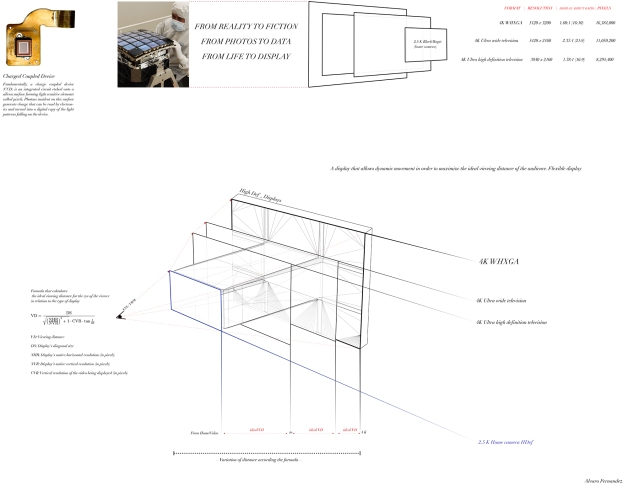
Diagram


Diagram
Charge Couple Devices – Transform Photos (light) into voltage (data). A hardware that transforms reality into mathematical relationships between pixel-organisms. This is the basics of Digital Capturing.
” A charge-coupled device (CCD) is a device for the movement of electrical charge, usually from within the device to an area where the charge can be manipulated, for example conversion into a digital value. This is achieved by “shifting” the signals between stages within the device one at a time. CCDs move charge between capacitive bins in the device, with the shift allowing for the transfer of charge between bins.
The CCD is a major piece of technology in digital imaging. In a CCD image sensor, pixels are represented by p-doped MOS capacitors. These capacitors are biased above the threshold for inversion when image acquisition begins, allowing the conversion of incoming photons into electron charges at the semiconductor-oxide interface; the CCD is then used to read out these charges. Although CCDs are not the only technology to allow for light detection, CCD image sensors are widely used in professional, medical, and scientific applications where high-quality image data is required. In applications with less exacting quality demands, such as consumer and professional digital cameras, active pixel sensors (CMOS) are generally used; the large quality advantage CCDs enjoyed early on has narrowed over time.”
4K displays – Along with retina and other HD+ displays, I will be undergoing a study on the precision of those type of ultra clear displays, without forgetting the formula that made them happen. Which is the CCD.
“Ultra high definition television (also known as Ultra HD television, UHDTV or UHD) includes 4K UHD (2160p) and 8K UHD (4320p), which are two digital video formats proposed by NHK Science & Technology Research Laboratories and defined and approved by the International Telecommunication Union (ITU).
The Consumer Electronics Association announced on October 17, 2012, that “Ultra High-Definition”, or “Ultra HD”, would be used for displays that have an aspect ratio of at least 16:9 and at least one digital input capable of carrying and presenting native video at a minimum resolution of 3,840×2,160 pixels.”